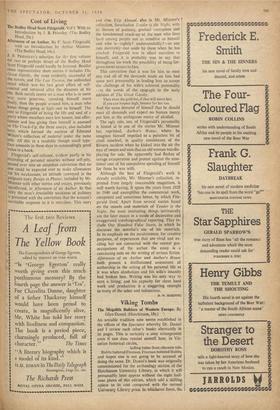Viking Tombs
The Megalith Builders of Western Europe. By Glyn Daniel. (Hutchinson, I8s.)
AN amiable tradition now seems established in the offices of the Spectator whereby Dr. Daniel and I review each other's books alternately in its pages. This is certainly a cosy arrangement even if one does remind oneself how, in Vic- torian historical circles, ladling butter from alternate tubs
Stubbs buttered Freeman, Freeman buttered Stubbs, and hopes one is not going to be accused of doing the same. Dr, Daniel's book was originally commissioned for the archmology section of the Hutchinson University Library, in which it will presumably later appear without the eight half- tone plates of this edition, which add a shilling apiece to its cost compared with the normal University Library price. In whichever form, the book is designed to give the general intelligent reader some idea of what he is looking at when he sees a megalithic chambered tomb, such as West Kennet in Wiltshire or New Grange in Ireland, and of what archaeologists are talking about when ominous words like Passage Grave and Gallery Grave creep into the conversation. It is an informed but popular survey of the earliest religious architecture of Western Europe.
I think the ordinary reader may find himself a little puzzled in the first chapter to know quite at what period of time and by what people the monuments he is reading about were built; Dr. Daniel, of course, tells him this, but perhaps not so clearly or directly as might save momentary bewilderment. Again, the discussions on ter- minology and the summaries of now-outdated views are rather confusing except for the pro- fessional. But on the whole, we have here for the first time a summary statement of current knowledge and opinion on the great family of stone-built collective tombs of Western Europe, of the centuries around 2500-1500 BC, presented in readable and attractive form. For France in particular, where the author's fieldwork and re- search have been centred for several years, we have an invaluable statement preliminary to his larger technical work to be published shortly.
We all have our pet idea about the means whereby the elaborate architectural traditions embodied in megalithic tombs were • in fact spread from the Mediterranean to the north : Childe visualised megalithic saints, Daniel pre- fers devout Vikings, but wisely says that no one theory need be held to account for all the distribution-patterns : 'it is at once the fascina- tion and the frustration of prehistoric arcteology' that our inferences have to be so tentative.
STUART PIGGOTT



































 Previous page
Previous page